Following World War I, Germany's economy was in ruins and there was rampant inflation. Due to the financial uncertainty and difficulty, of the 86 German car factories operating in 1924, only 19 were in existence three years later. Among them were Daimler and Benz, but both understood that if they were to survive, it would have to be in partnership. Thus, the two great rivals completed their merger on July 1st of 1926, having paved the way with a technical co-operation agreement in 1924. By this point in history, Professor Ferdinand Porsche had taken the company's Chief Engineering position left absent by Paul Daimler (founder Gottlieb's son) when he moved to Horch. Both Paul Daimler and Porsche were advocates of forced induction, and although Porsche left Daimler-Benz in 1928, he left a lasting impression and a range of supercharged ('Kompressor') Mercedes motors cars. 
Town Car by Murphy
View info and historyPorsche arrived at the company early in 1923 and among his early priorities were further developing the blown four and eight-cylinder race cars designed by Paul Daimler, along with the 15/70/100hp and 24/100/140hp supercharged, six-cylinder production models that would be introduced at the Berline Automobile Show in 1924. Daimler-Motoren-Gesellschaft had introduced the world's first supercharged production cars, the 6/25/40hp and 10/40/65hp four-cylinder models, at the 1921 Berlin Automobile Show. The three separate figures in the model's name were in references to nominal rated horsepower, horsepower un-blown, and horsepower with blower engaged respectively. Following the company merger in 1926, the 15/70/100hp was reclassified as Type 500 and the 24/100/140hp became the 630. Also that year, a 'K' (Kurz Radstand - short wheelbase) version became available for the first time, resting on a wheelbase that had been reduced from 148-inches to 134-inches. The 'K' was available as a four-door 'Sports four seater' or as a two-door 'Roadster.' The three stout metal pipes exiting the right side of the hood would become a hallmark of the Mercedes-Benz 'Kompressor' cars. The three pipes discharged the car's exhaust gases, merging at the lower edge of the hood into a large single exhaust pipe. 
La Baule Torpedo Transformable by Saoutchik
Chassis #: 385133
Engine #: 60793
View info and history
Auction entries : 3The engine powering the 630K displaced 6.3-liters and was nearly identical to the engine powering the successful SSK racing models. It was a single-overhead-camshaft six-cylinder unit with an unusual 'bevel linkage' feature and delivered 138 horsepower with the Roots supercharger engaged. The supercharger was motivated by pressing the throttle pedal to the floor, causing it to come to life and endow the engine with even more horsepower for brief periods of time. With the supercharger engaged, the 630K could justifiably claim to be the world's fastest production touring car, capable of top speeds in excess of 90 mph. The engine was backed by a four-speed manual transmission that used a multi-plate dry disc clutch ('Mehrscheibentrockenkupplung'). The gear change was operated by a gear level that was initially to the driver's right, directly outside the door. It was later relocated to a more conventional location in the middle of the floor to the driver's left. The suspension configuration was also conventional, employing rigid beam axles and semi-elliptic leaf springs. Stopping power was provided by a cable linkage operating on all four wheels. A vacuum-powered support ('Saugluftunterstützung') was added in 1928. The Mercedes 630K was a Paragon with Herculean power, prestige, and elegance. Only the wealthy and most influential clientele were capable of affording these exclusive vehicles, with less than 400 examples built between 1926 and May of 1929. As many as 299 examples were built in 1928, 44 cars in 1927, and 12 in 1926. Just 22 examples were built in its truncated final year of production. Many examples wore 'factory' coachwork by Sindelfingen, while others wore custom coachwork by notable craftsmen such as Erdmann & Rossi, Reuter, Papler, Zschau, Jacques Saoutchik, Castagna, Stabilimenti Farina, Murphy, Hibbard & Darrin, D'Ieteren Frères, and Balzer.
Town Car by Murphy
View info and historyThe Typ 630 was replaced by the more powerful and larger Mercedes-Benz Typ 770 (W07). Production of the SS and SSK (Typ 06) had begun in 1928, although in small numbers. These were sports-bodied cars that continued to carry the performance banner for the Mercedes-Benz marque. The Mercedes-Benz 630 incorporated knowledge gained on the track from the company's successful racing program and were among the most expensive, exclusive, and elegant vehicles of their era.
by Daniel Vaughan | Jul 2021

Town Car by Murphy
View info and history

La Baule Torpedo Transformable by Saoutchik
Chassis #: 385133
Engine #: 60793
View info and history
Auction entries : 3

Town Car by Murphy
View info and history
by Daniel Vaughan | Jul 2021
Related Reading : Mercedes-Benz 630K History
Ferdinand Porsche designed the S-Type for Mercedes-Benz in 1927. The racer was constructed using pre-existing road version Mercedes vehicles, mainly the 400 and 630 models. The names of these vehicles came from their displacement size in liters. For example, the 400 had a four-liter engine while the 630 had a 6.3-liter engine, both were equipped with a supercharger and six-cylinders. The engine was....
Continue Reading >>
Continue Reading >>
1928 Mercedes-Benz 630K Vehicle Profiles
Recent Vehicle Additions
Performance and Specification Comparison
630K Specification Comparison by Year
Year
Production
Wheelbase
Engine
Prices
Related Automotive News

Past Best of Show Winners at The Pebble Beach Concours d'Elegance
overview1
The 70th anniversary of the Pebble Beach Concours dElegance was celebrated with a spectacular display of previous Best of Show winners. Thirty-seven examples graced the showfield and many were still with the same owners who raised the trophy...

Bugatti Celebrates the 70th Anniversary of the Legendary Pebble Beach Concours d'Elegance
A Bugatti model was present at the first ever Pebble Beach Concours dElegance in Monterey, California, in 1950, and the iconic french luxury brand holds a record nine Best of Shows awards.table width100 rolepresentation border0 cellspacing0...

BONHAMS RETURNS TO STUTTGART WITH A MIGHTY MILLION EURO MERCEDES-BENZ
Bonhams return to Stuttgart for the annual single-marque Mercedes-Benz sale will be led by the magnificent 1928 Mercedes-Benz Model K 6,240cc Supercharged Torpedo Transformable. With its superb Saoutchik transformable coachwork, it is estimated at €800,000-1,200,000.
Wi...

Concours d'Elegance of America at St. John's : Best of Show
The Concours dElegance of America, established in 1978, featured over 300 significant automobiles on the beautiful green at the Inn at St. Johns in Plymouth, Michigan. This years featured classes included Vintage Bentley, Auto Show 55, Bonneville...

Auctions America Continues Successful 2013 Season with its Annual Fall Carlisle Sale
Auctions America rounds out its 2013 auction season in Carlisle, Pennsylvania, October 3-4
Two-day Fall Carlisle sale, held in conjunction with the Carlisle Events Collector Car Swap Meet %26 Corral, features a diverse roster of 300 classics, exot...

























